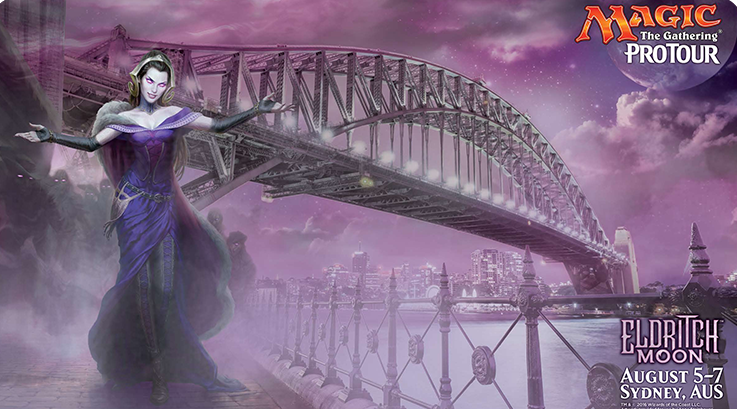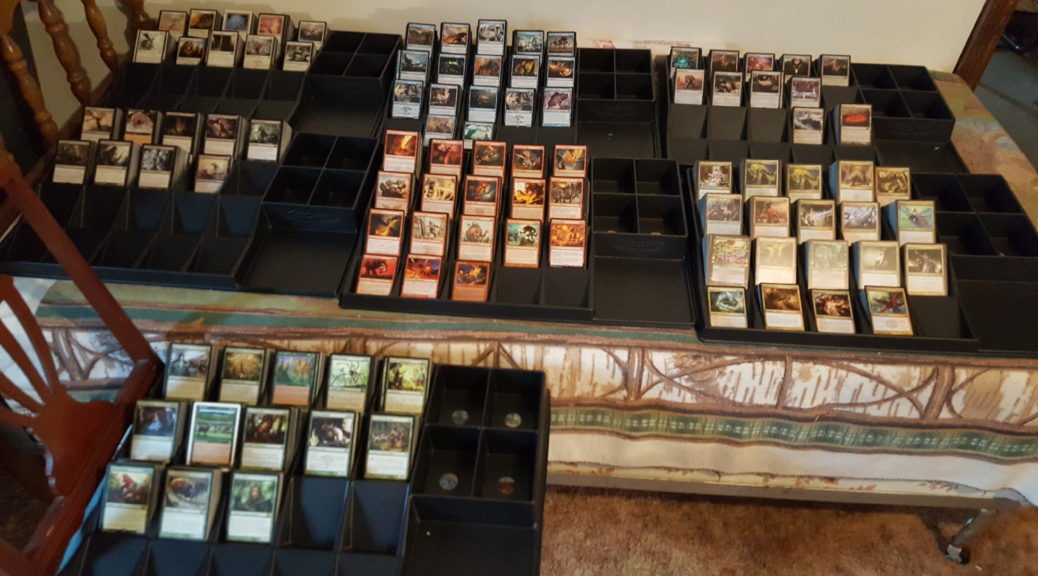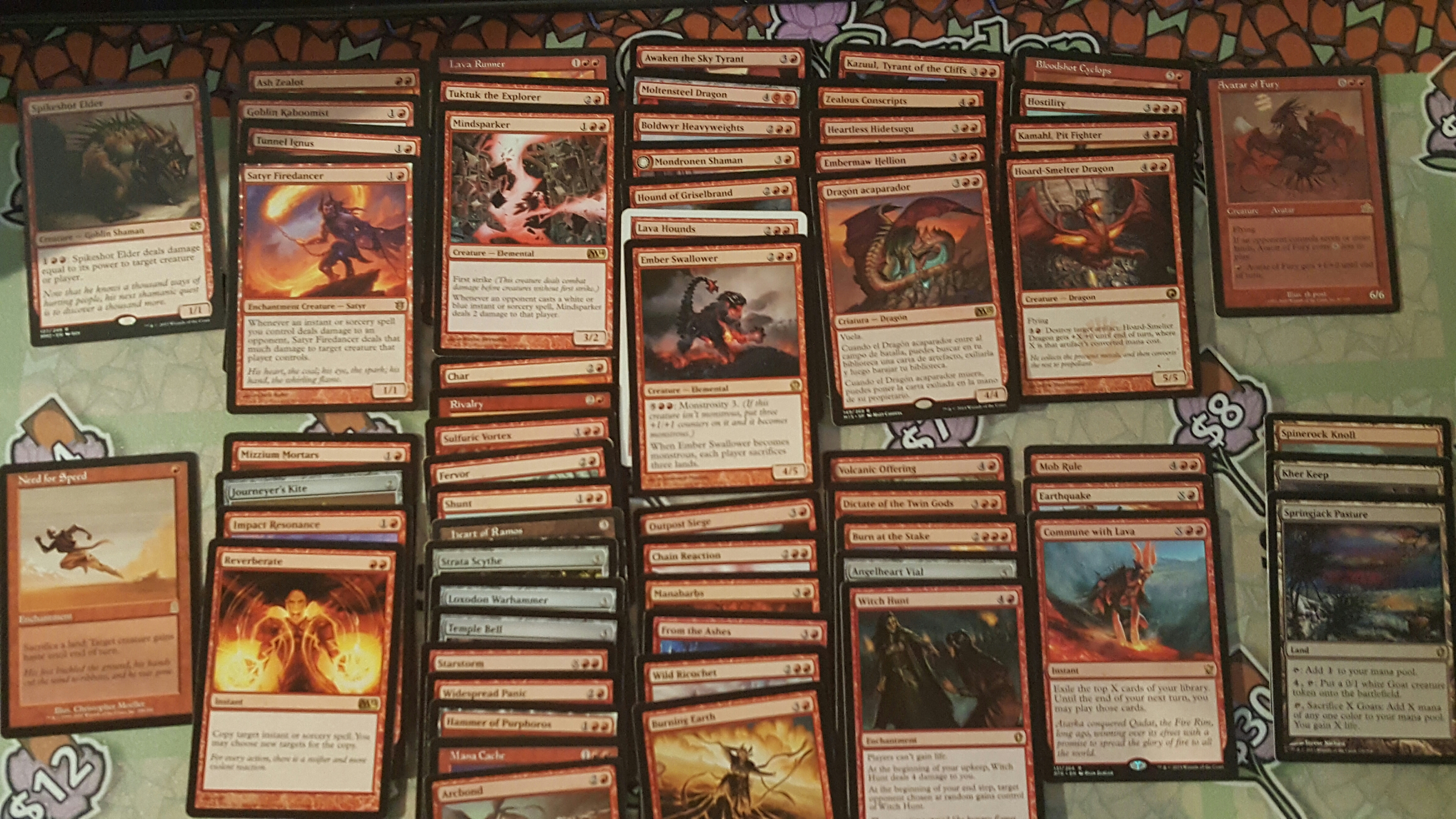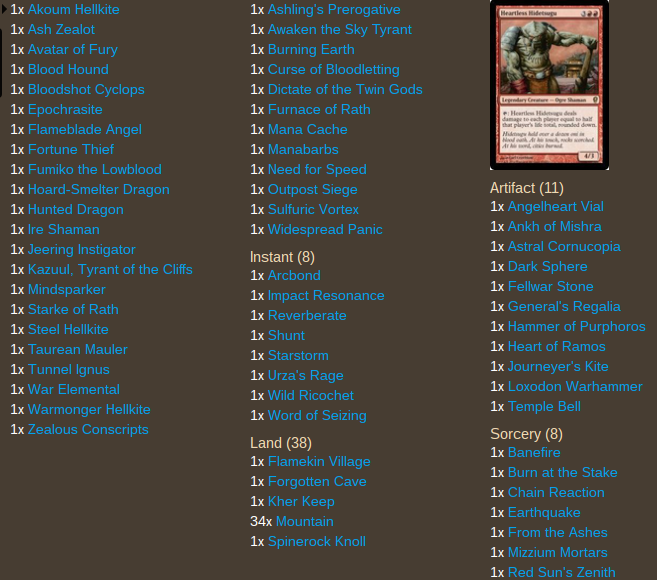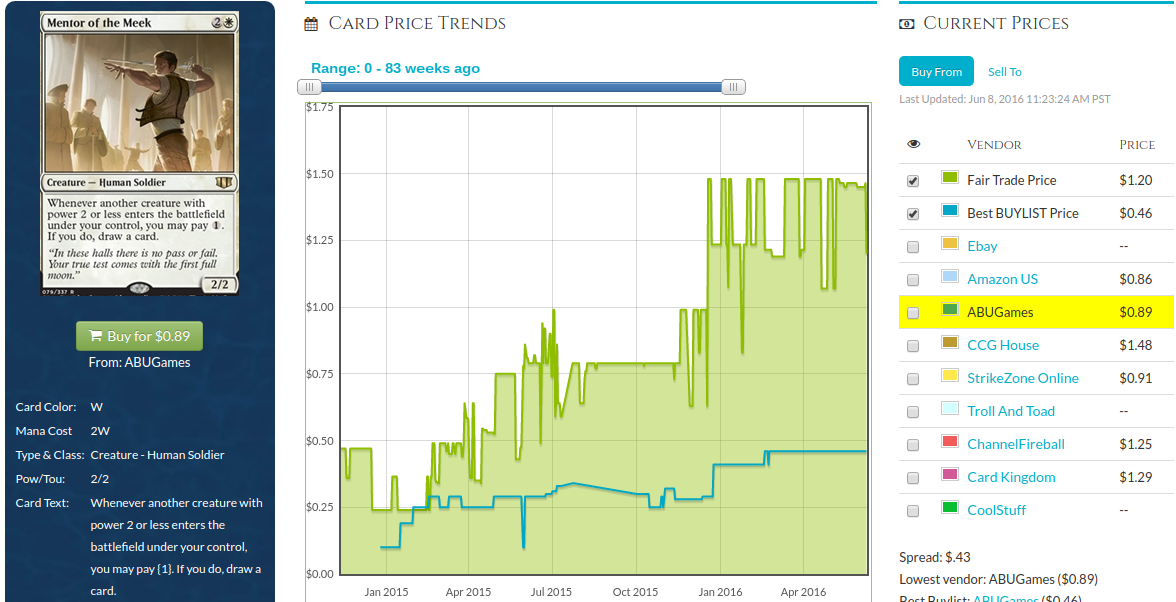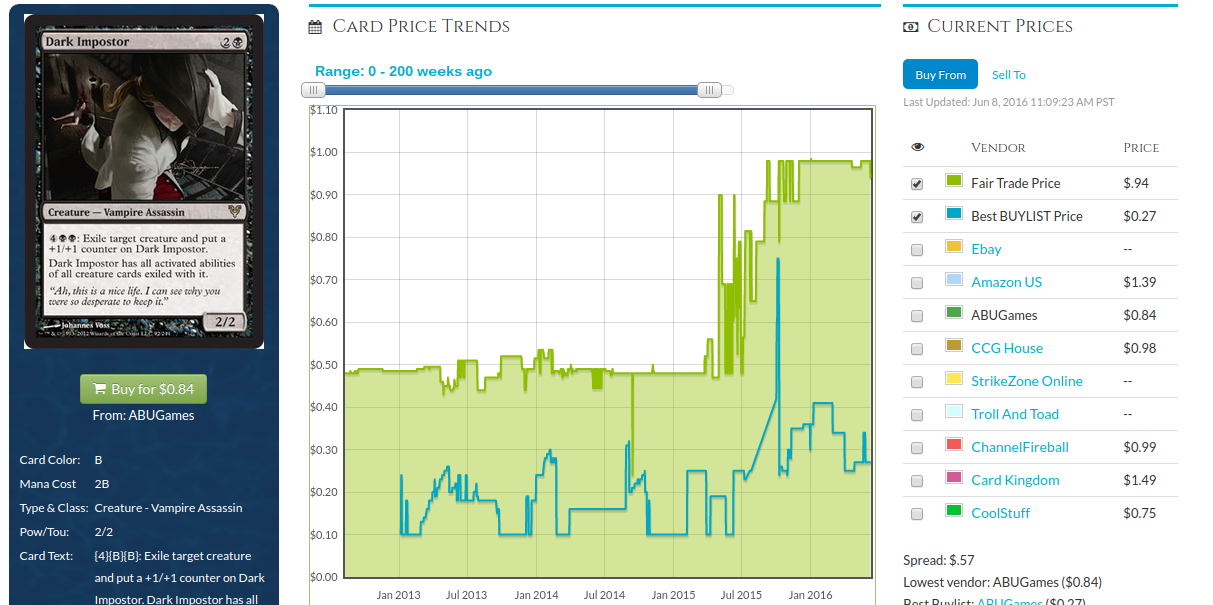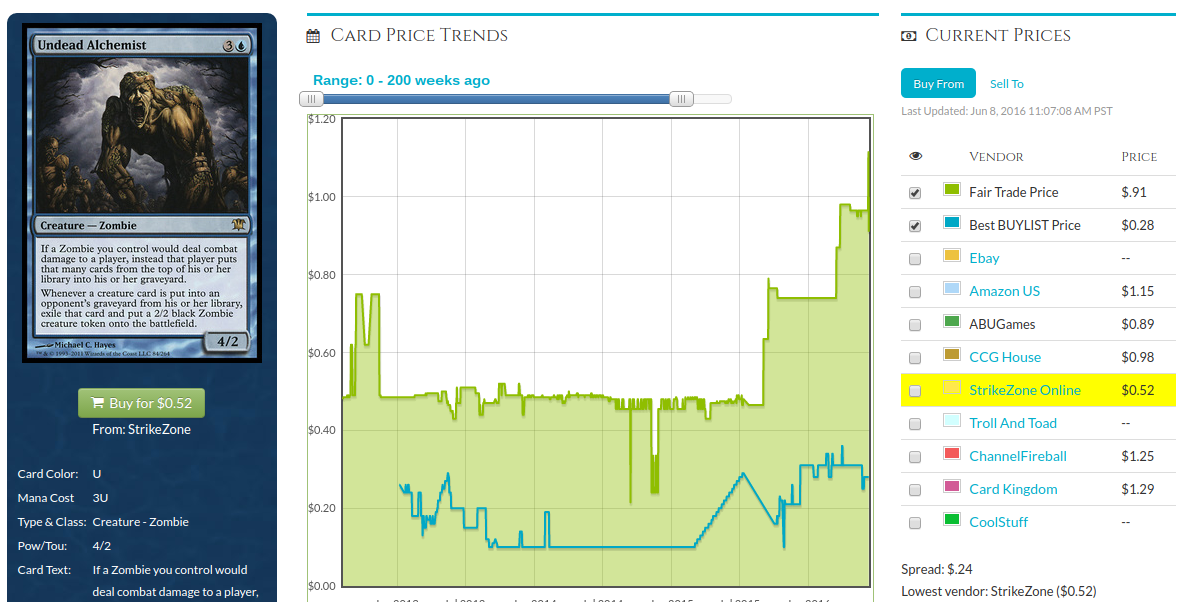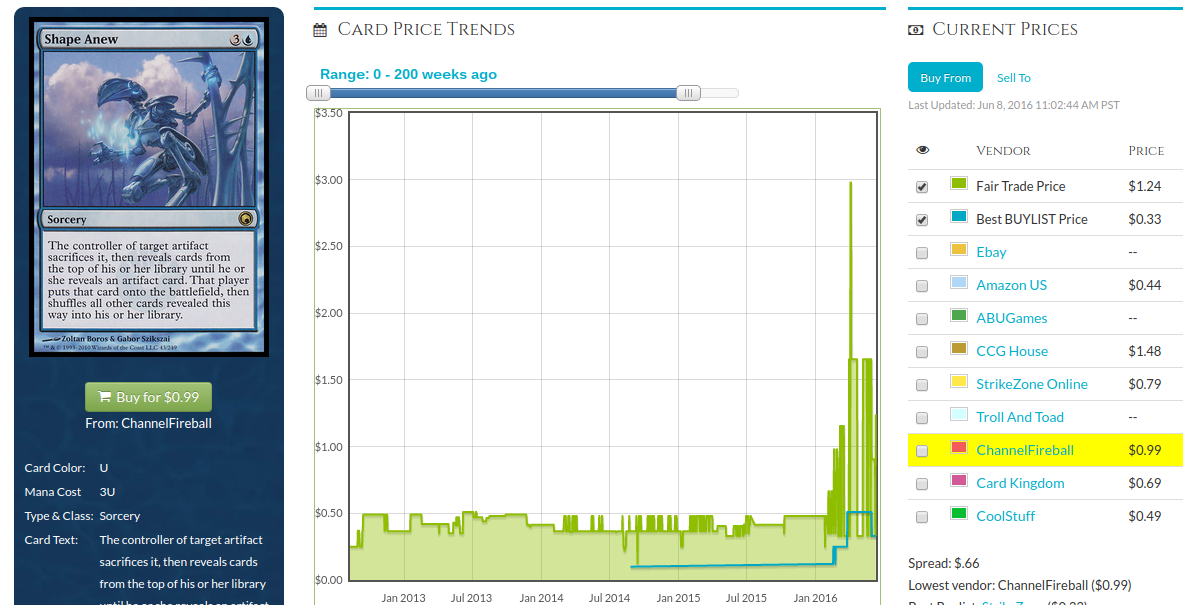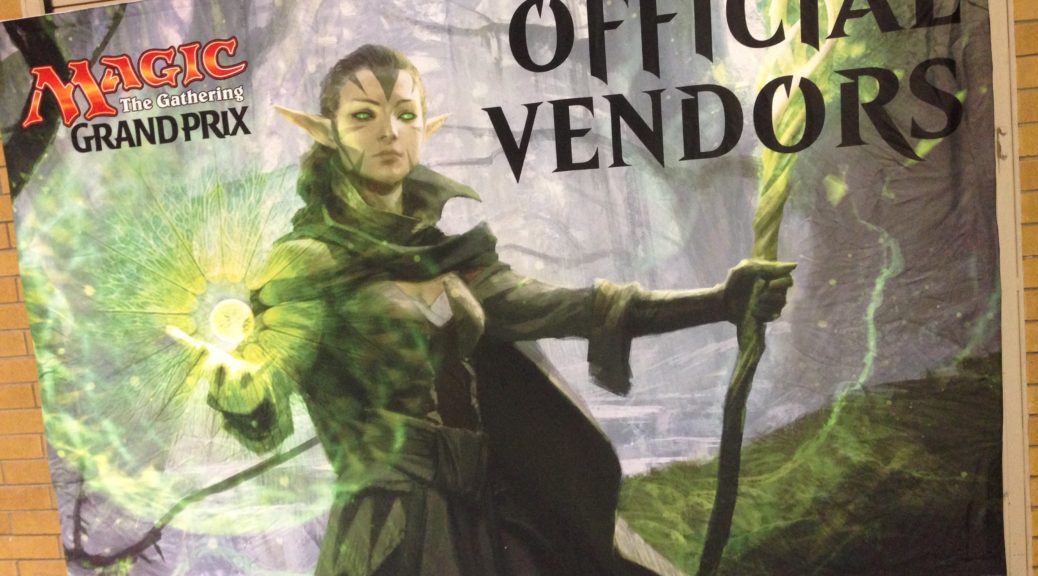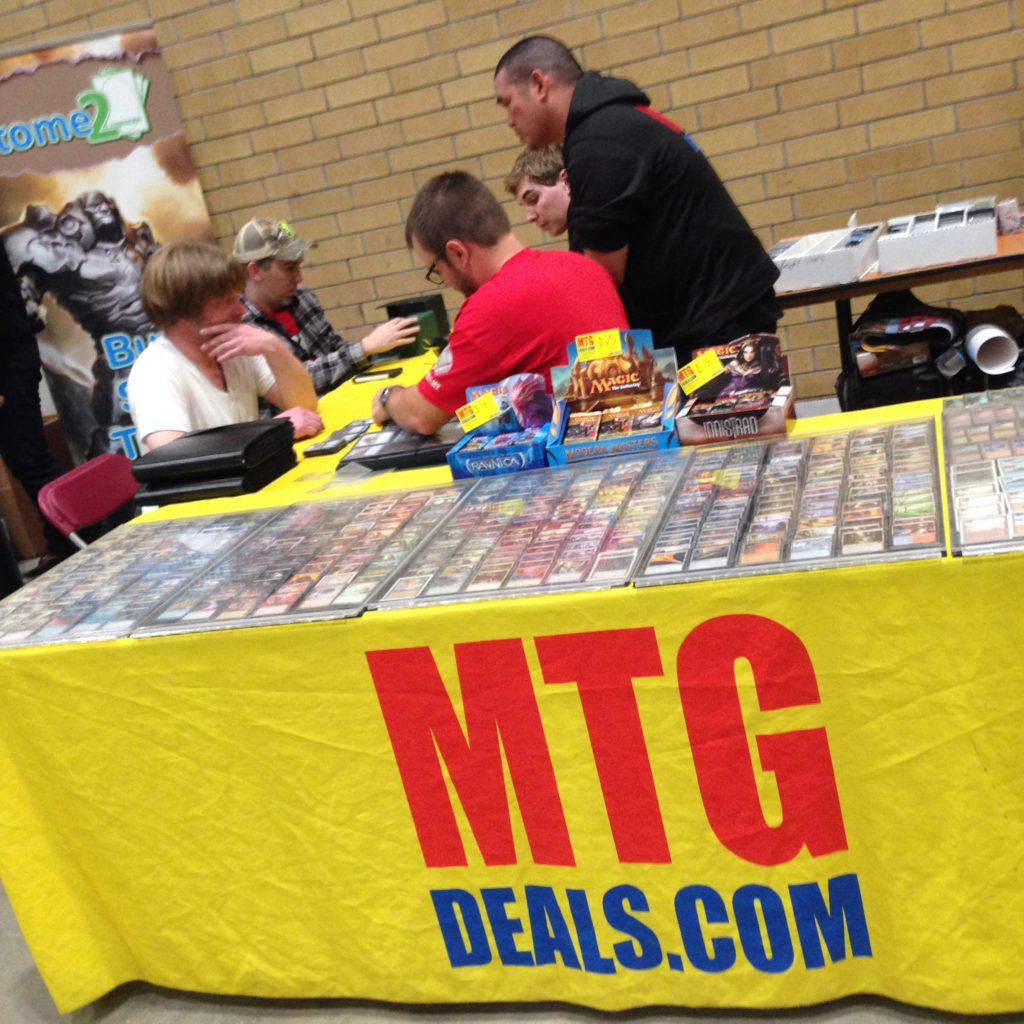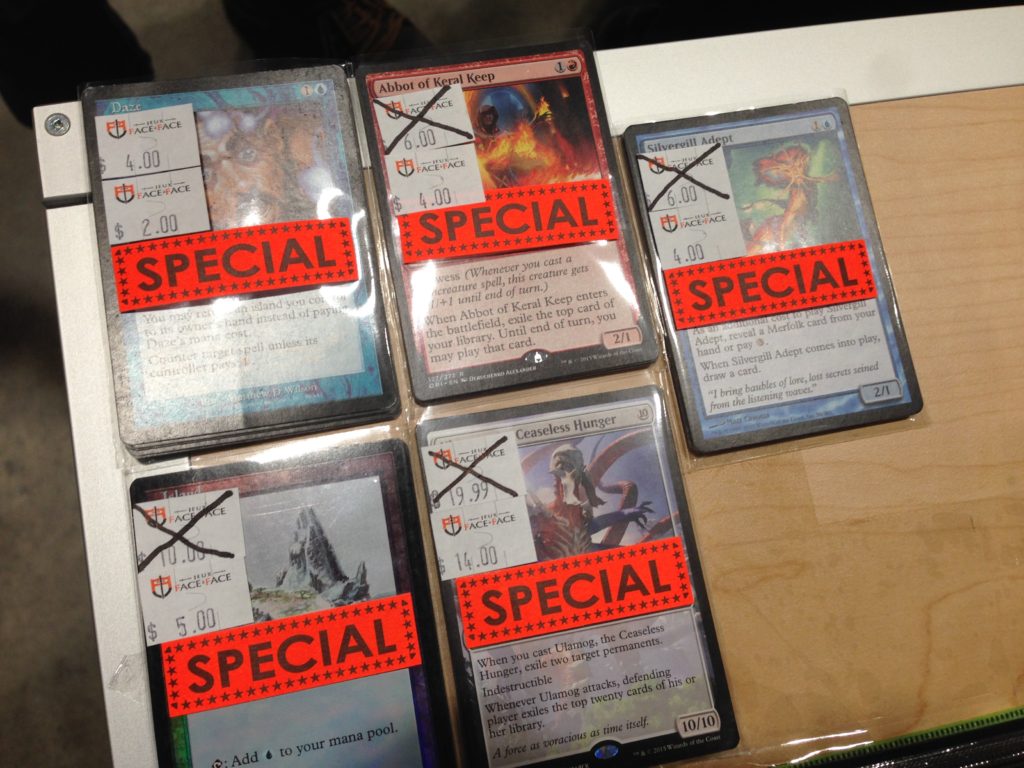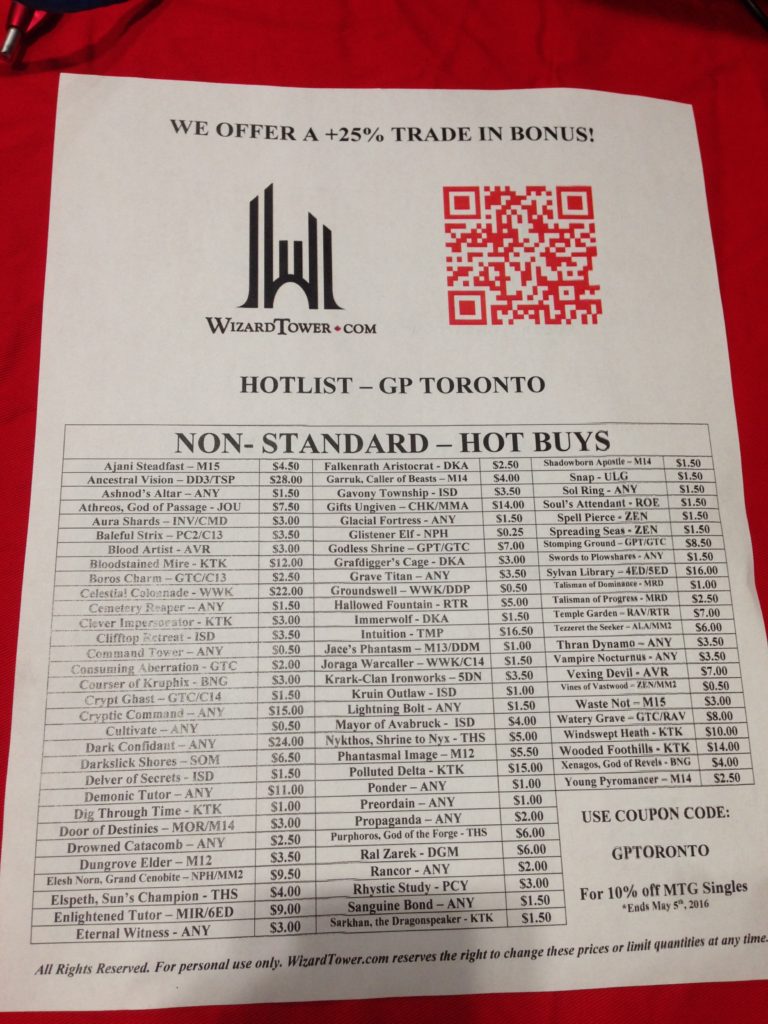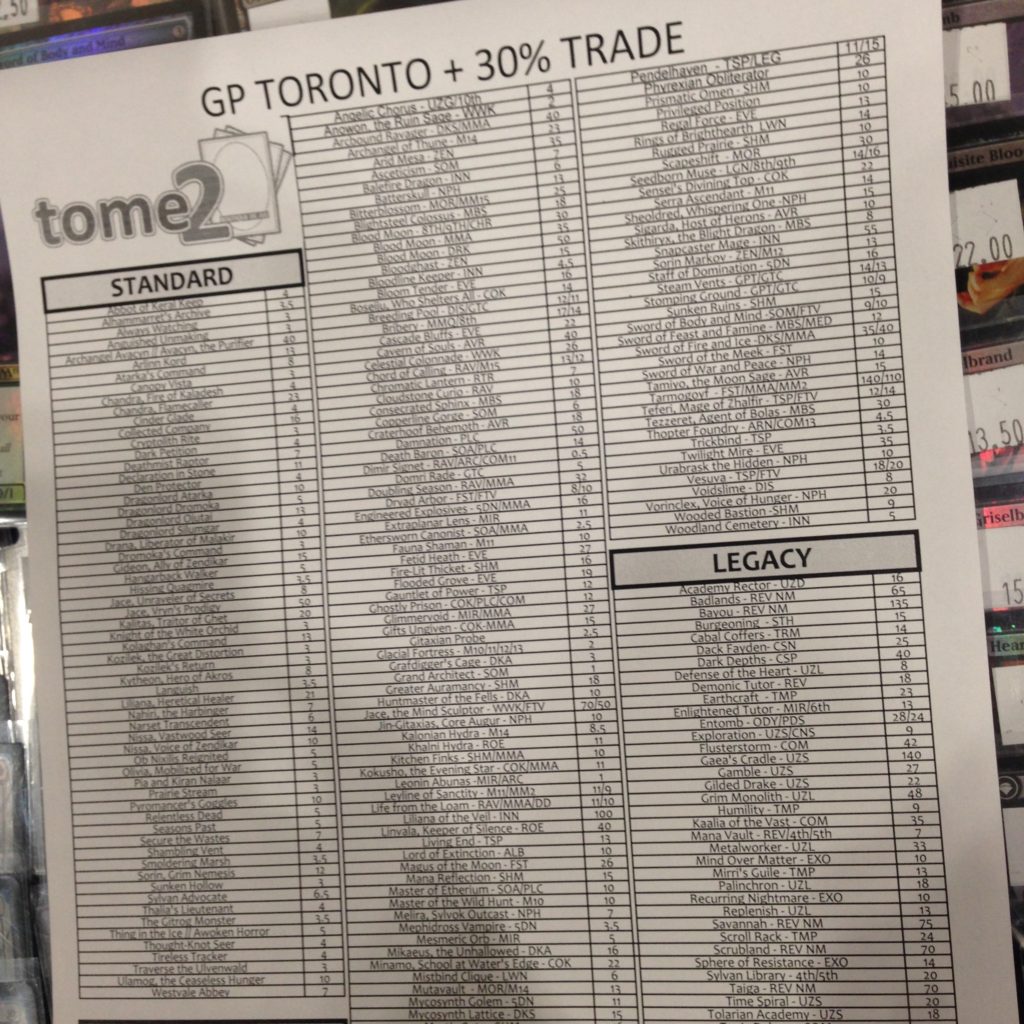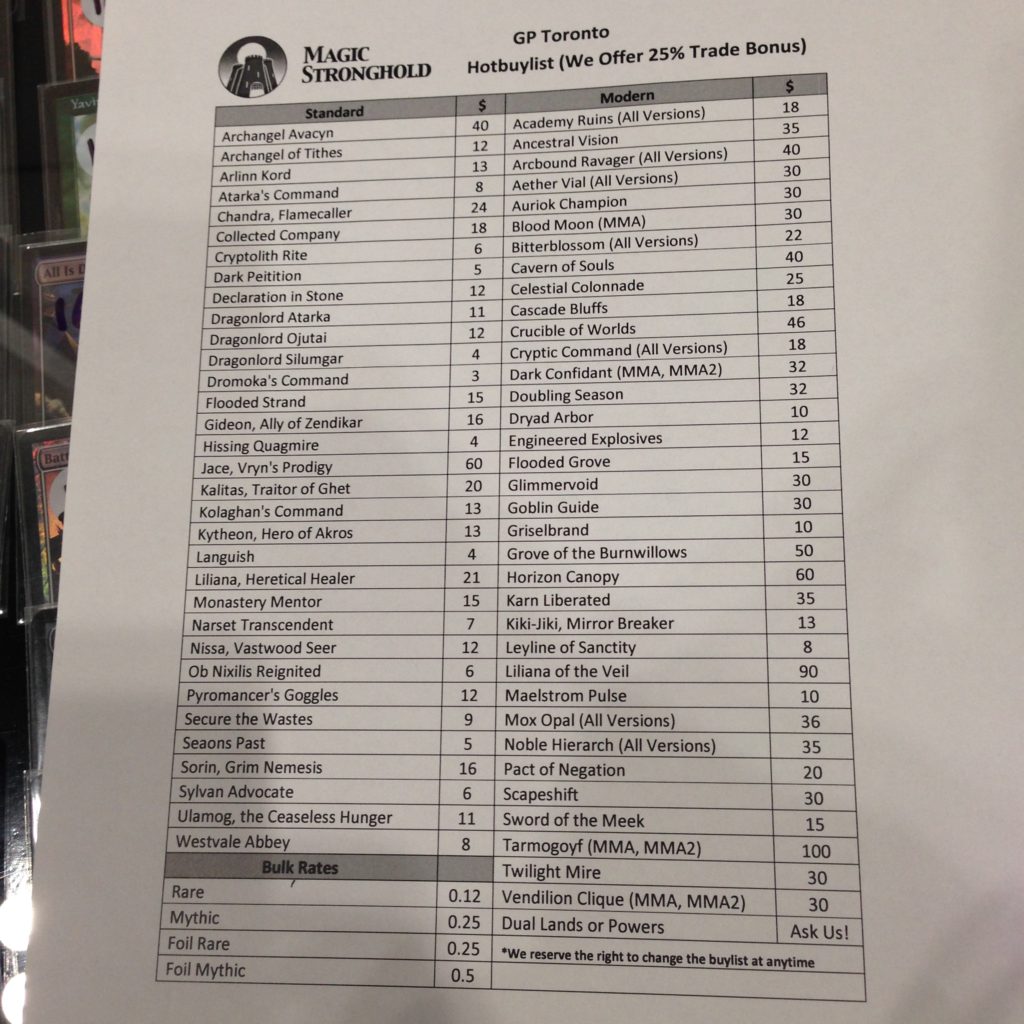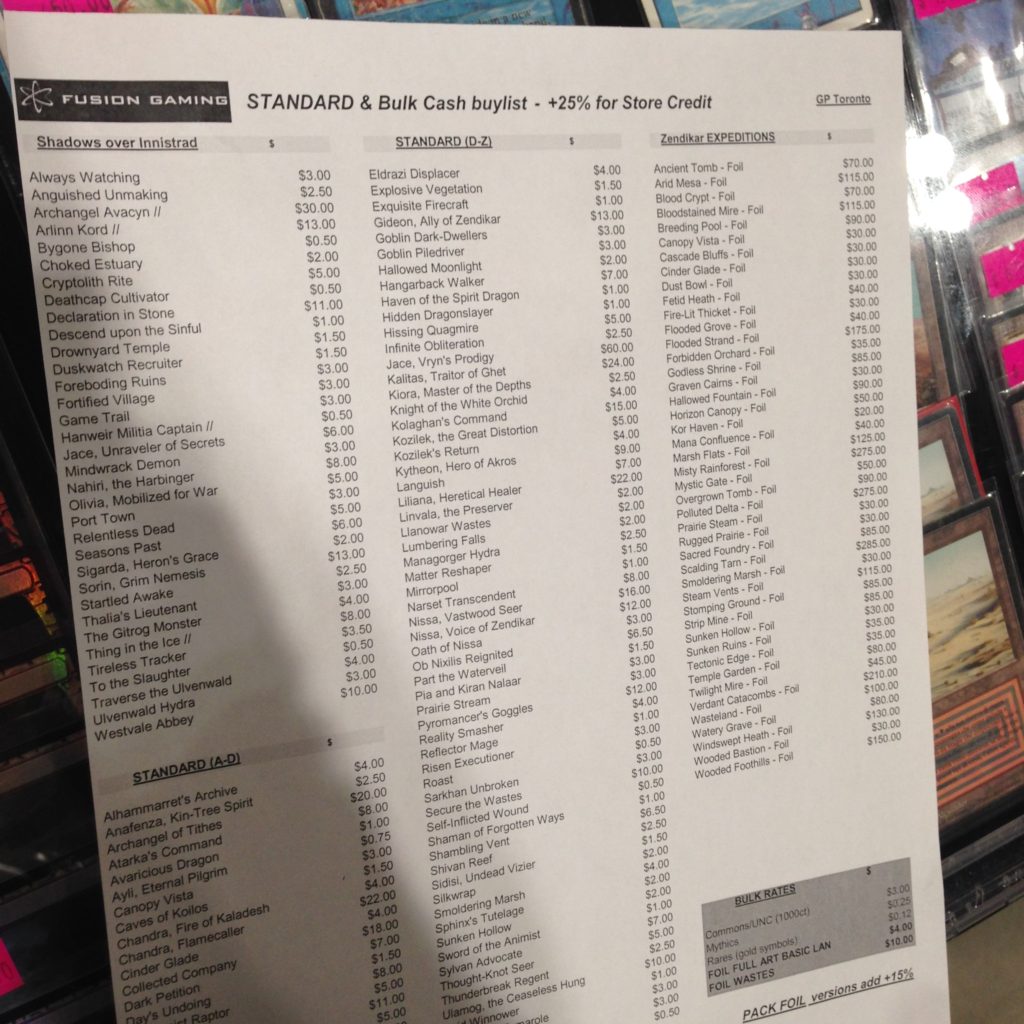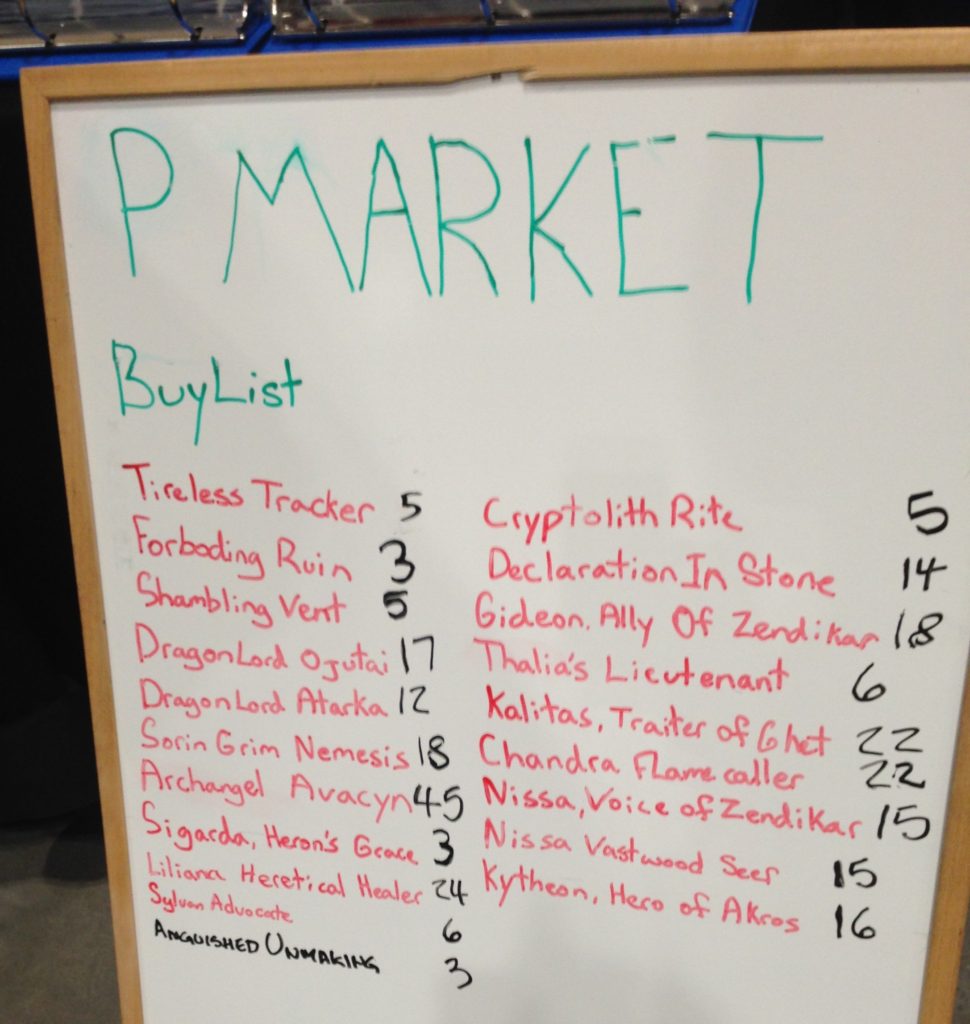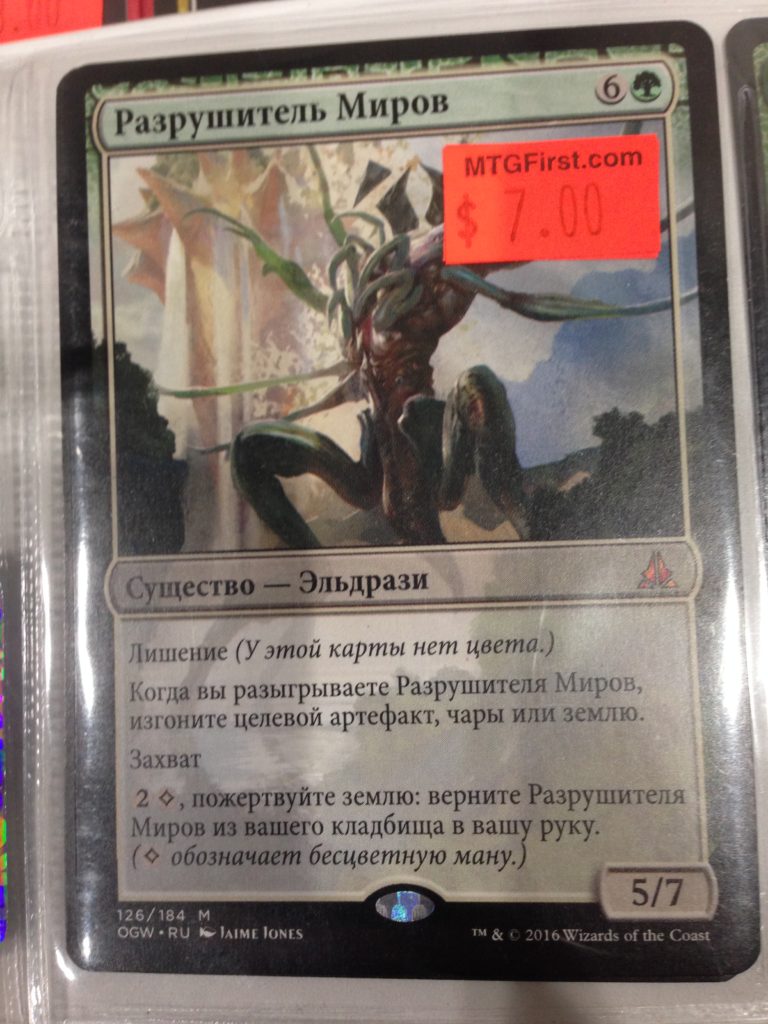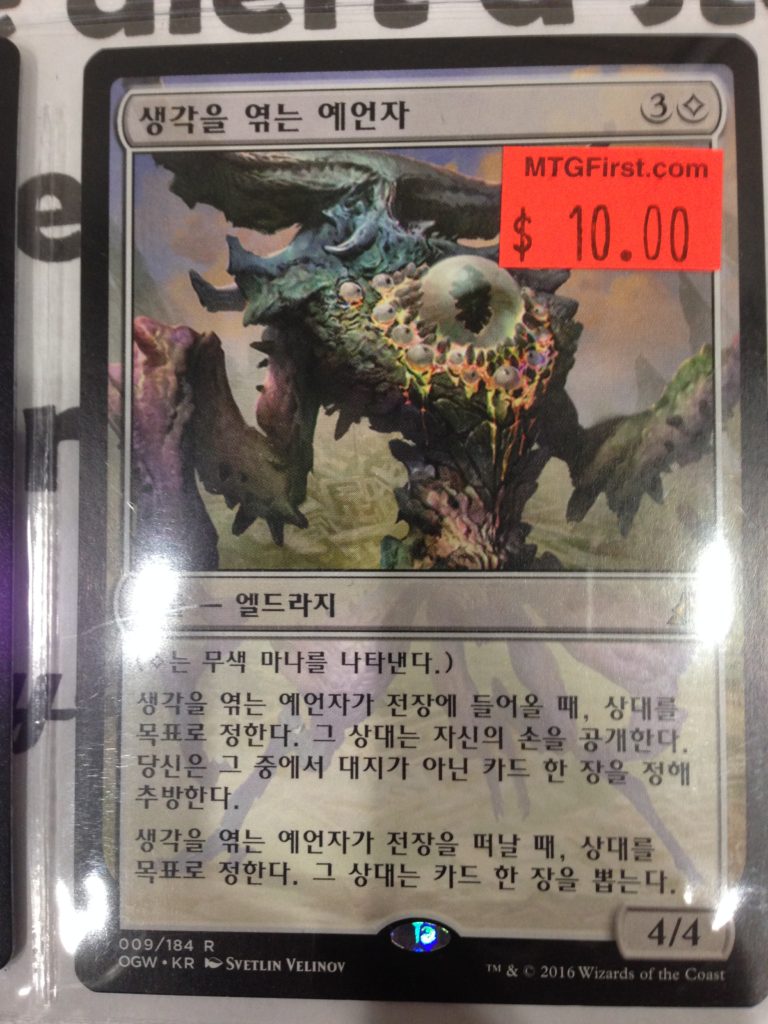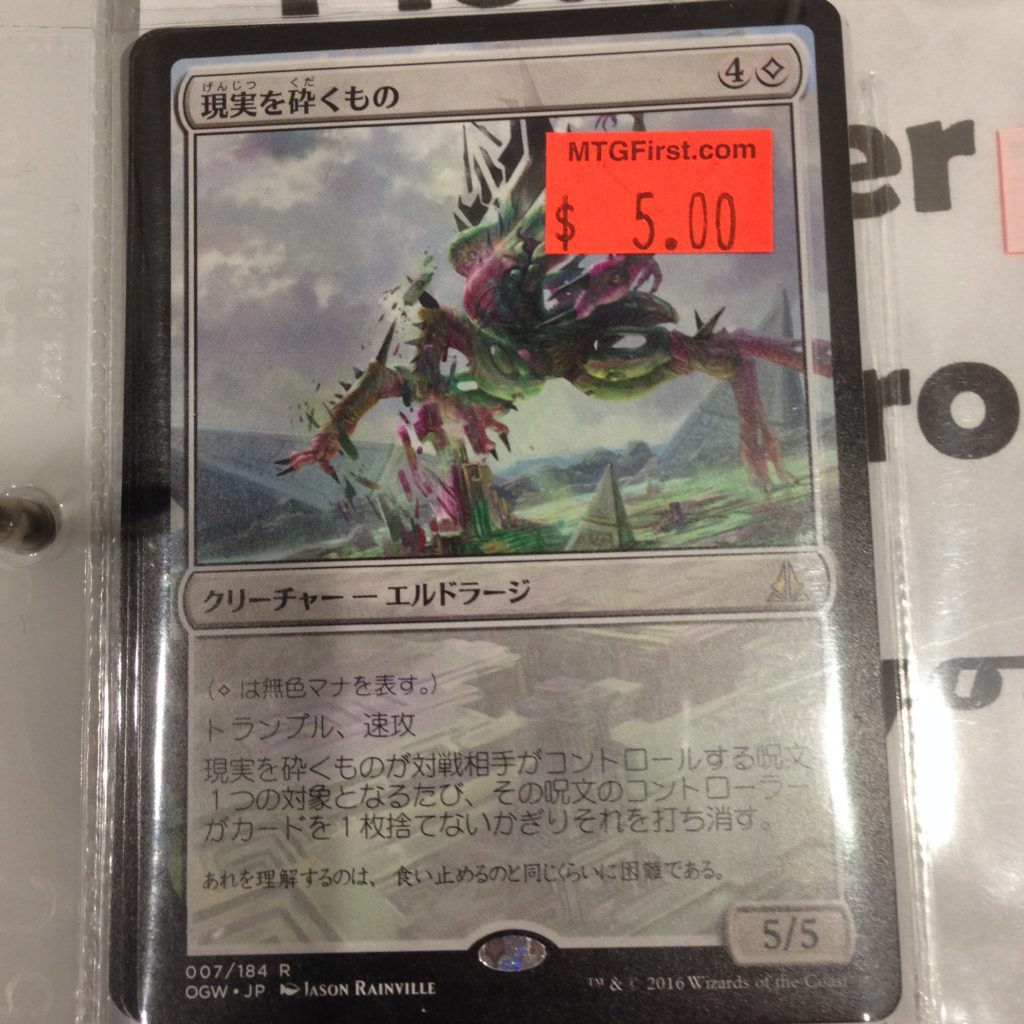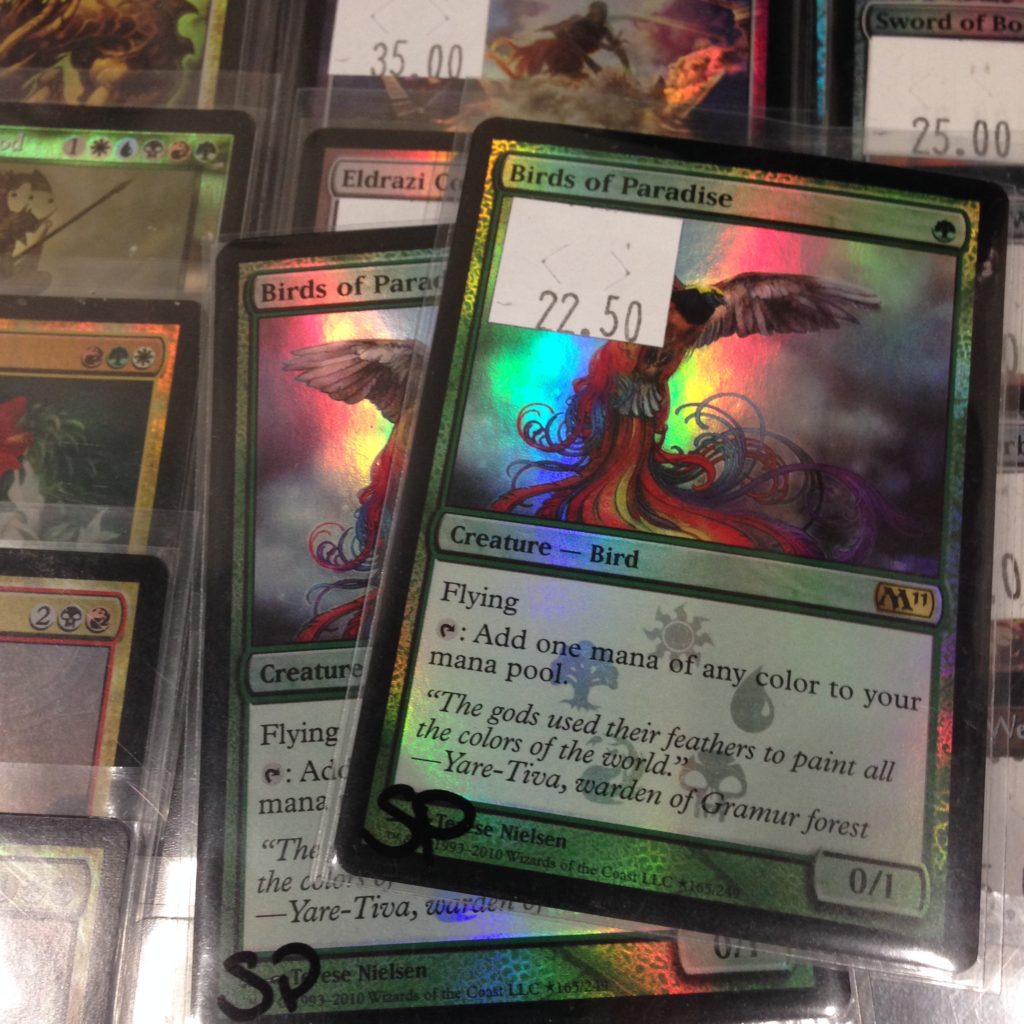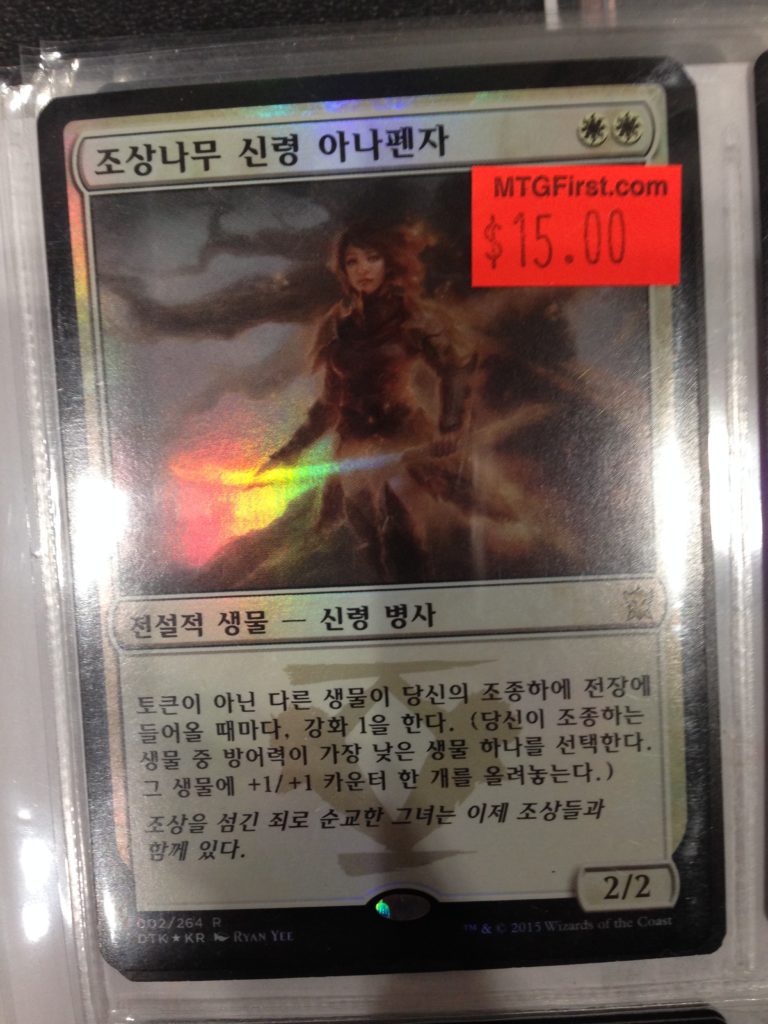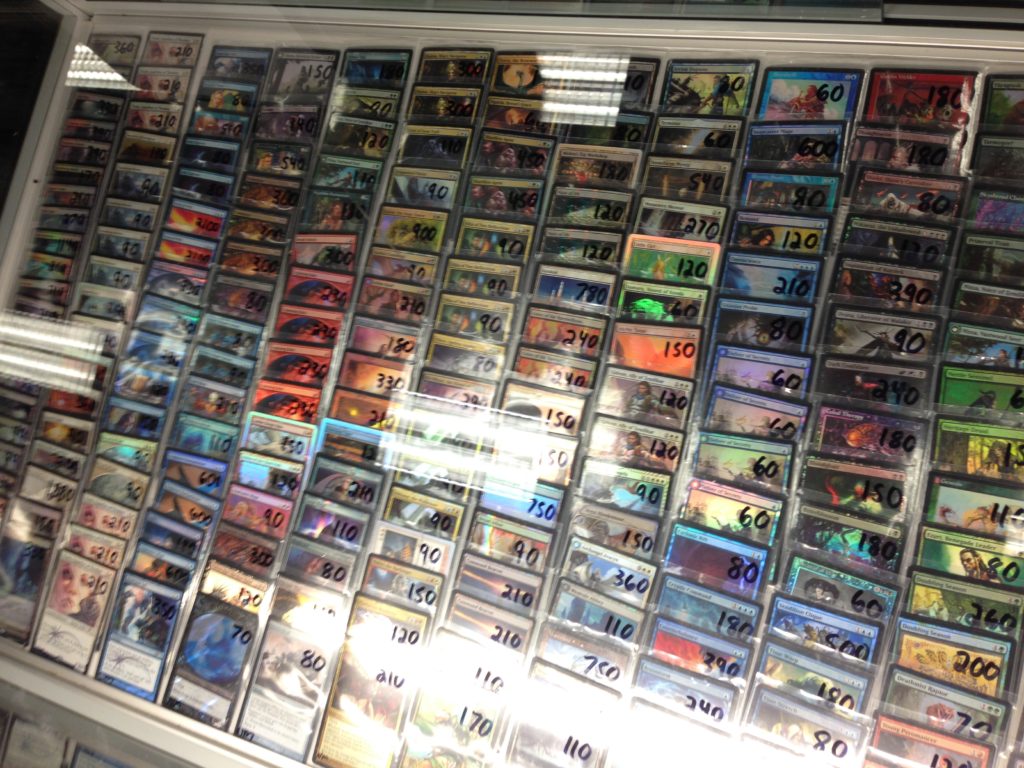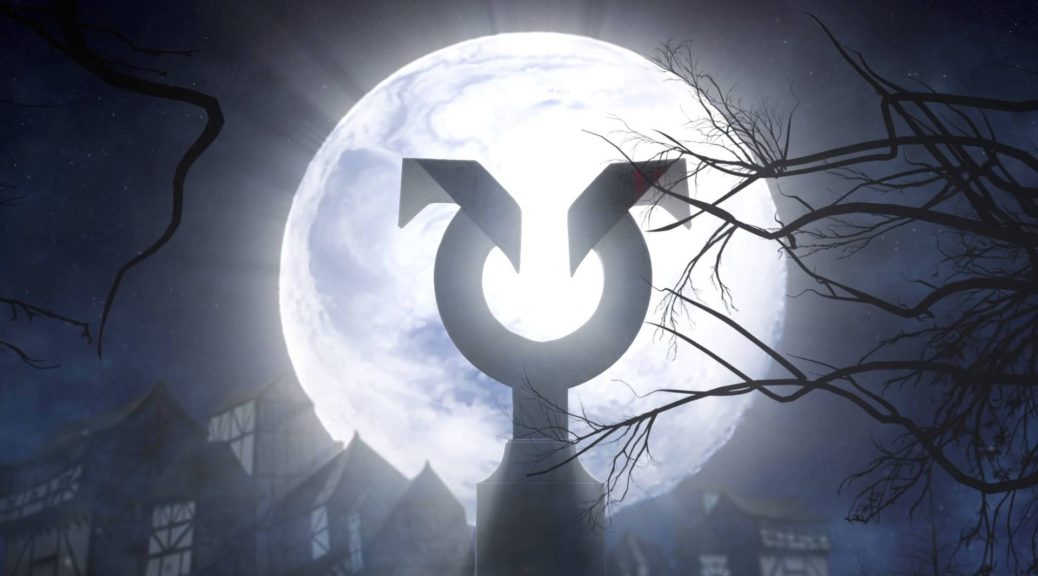Our Top 8 for Pro Tour Shadows Over Innistrad has been made official:
- 1st, Jon Finkel: B/G Control (Dark Petition, Seasons Past, Hissing Quagmire)
- 2nd, Seth Manfield: Esper Control (Dark Petition, Narset, Ascendant, Ob Nixilis)
- 3rd, Brad Nelson: R/G Goggles (Pyromancer’s Goggles, World Breaker)
- 4th, Luis Scott-Vargas: B/G Aristocrats (Collected Company, Cryptolith Rite)
- 5th, Shota Yasooka: Esper Dragons (Dragonlord Ojutai)
- 6th, Steve Rubin: G/W Tokens (Nissa, Gideon, Avacyn)
- 7th, Luis Salvato: R/W Eldrazi (Thought Knot-Seer, Archangel Avacyn, Nahiri, The Harbinger)
- 8th, Andrea Mangucci: Bant Company (Collected Company, Archangel Avacyn)
It’s worth noting that with eight entirely different decks in contention, the finals is likely to be the final word in which of the cards listed above make a move or hold their gains. The cards with the most copies across all Top 8 decks seem to include Archangel Avacyn, Dark Petition, and Collected Company. I would expect that Pyromancer’s Goggles will cement a price tag over $15, and possibly over $20 if it makes the finals. Cryptolith Rite looks very real, and should be able to hold any price below $10 easily. Tune in tomorrow for Top 8 coverage!
—————————————————–
Seth Manfield wins his match. He is a lock for Top 8, and Narset Transcendent has a chance to gain some ground, especially if he makes the finals.
Round 16: Luis Scott-Vargas (G/B Aristocrats) vs. Chye Yian Hsiang (White Humans)
Faced with dangerous tie breakers and successive rounds of opponents that need to win to Top 8, LSV finds himself needing to win his final match to make Top 8. In Game 1, early pressure from Hsiang is met with a mid-combat Collected Company, helping LSV turn the corner and stabilize against the aggro deck. With Westvale Abbey in play and a Zulaport Cutthroat on the table, LSV looks for a gap to drive home the demon prince. Knocked down to three life on the next attack, LSV finds another Collected Company off the top to nab a 2nd Cutthroat and a Catacomb Sifter, giving him a large enough army to claim the game off of multiple drain triggers and a high flying demon attack.
Game 2 runs much the same way, with early pressure shrugged off by drain life gain via Cutthroat and LSV manages to combo his way into his seventh lifetime Top 8!
Deck Tech: G/B Control (Reid Duke)
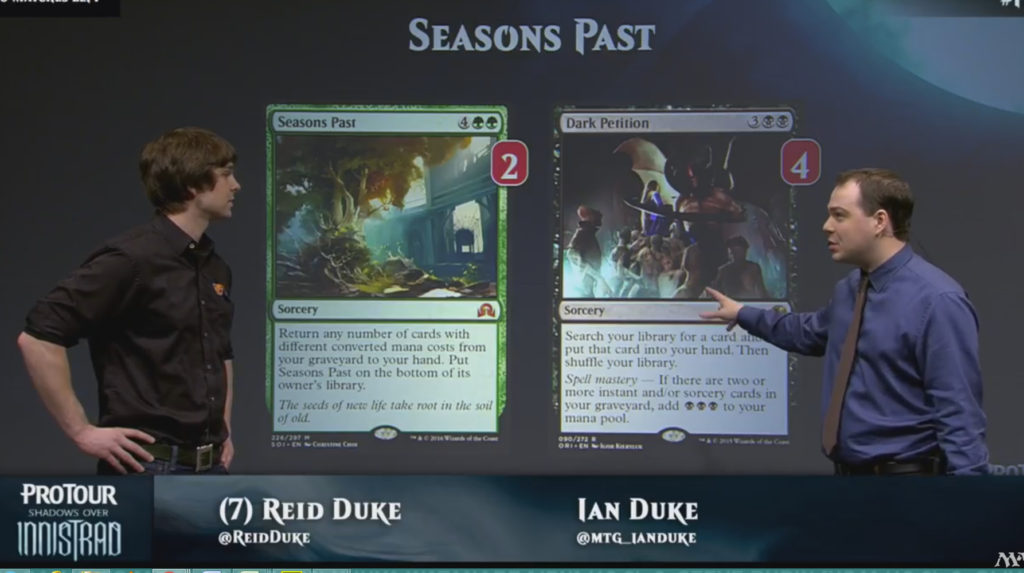
Reid explains that black has the best removal, green has the best ramp spells, and the Dark Petition/Seasons Past combo is too strong to ignore. Notable that the deck only runs two copies of Seasons Past, which may limit price movement, depending on how the deck finishes in the Top 8. Deck also runs Infinite Obliteration as a single copy, and two copies each of Transgress the Mind and Duress. Obliteration has the potential to recursively remove all remaining threats in an opponent’s deck if the game goes long enough. Ruinous Path is a three-of. Two copies of Kalitas, and four copies of Languish, a card that could easily hit $5 if that number becomes common. Hissing Quagmire is a four-of as well, and interacts well with Ruinous Path. This land could easily double up this week to $6 from $3.
Round 15: Jon Finkel (B/G Control) vs. Luis Salvato (R/W Control)
To be this deep in the tournament and still seeing hot new decks at the top tables is pretty insane. Slavatto is running a build with Thought-Knot Seer, Chandra, Flamecaller, Goblin Dark-Dwellers, Fall of the Titans, Lightning Axe, Pyromancer’s Goggles, Secure the Wastes and Westvale Abbey. Goggles seems destined to top $20 this week as a card that is being abused in at least three viable color combinations.
The players split the first two games. Late in Game 3, Jon has a full grip, but Salvatto manages to get in a big hit with seven Secure the Wastes tokens, and takes a Languish with his Thought-Knot Seer. Sitting at nine life, Jon has fourteen lands in play but no immediate answer to the token army and is forced to lay Kalitas and pass. Salvato decides to cash his army in for Ormendahl, and falls into a waiting trap with Finkel taking down the profane prince using a double Grasp of Darkness.
Salvato attempts to rebuild with Nahiri, the Harbinger, but Jon starts in with the Dark Petition/Seasons Past recursion and Salvato extends the hand. Finkel stands all alone at 14-1 surveying his kingdom at securing the top seed in the Top 8.
Round 15: Steven Rubin (G/W Tokens) vs. Yuuya Watanabe (Mono-White Humans)
Both players are on 11-3 and need a win to guarantee Top 8 access. Rubin takes the first game with his token deck configured to tackle the expected white weenie strategies at the tournament. In game 2, Watanabe gets stuck on land, and Rubin puts the match away to put Hangarback Walker, Nissa and Gideon into the Top 8.
Deck Tech: G/R Goggle Ramp (Pierre Dagen)
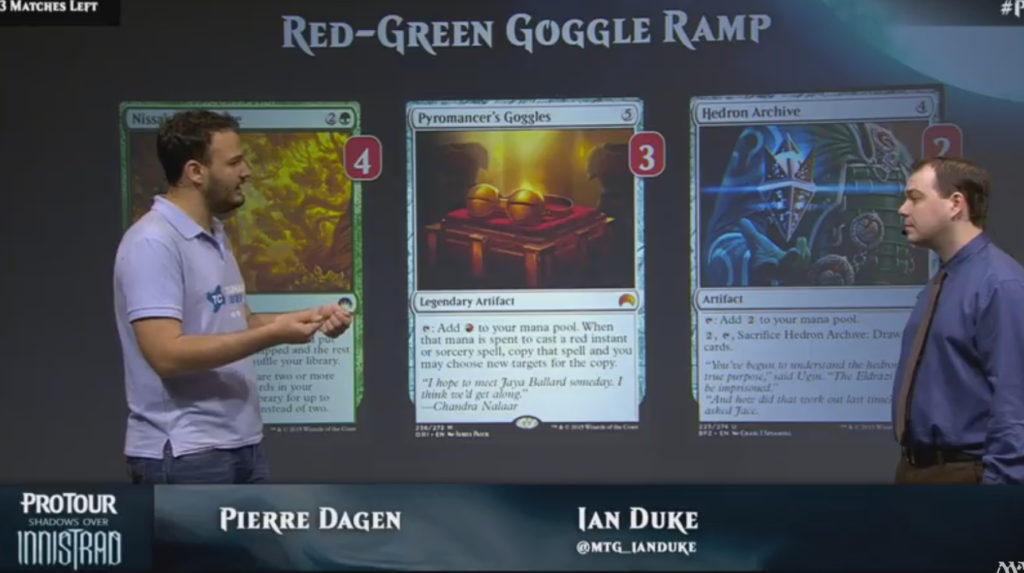
Dagen outlines that beating Collected Company decks using Goggles to go over the top in lieu of Ugin, the Spirit Dragon resulted in the genesis of the deck. Deck runs three copies of Pyromancer’s Goggles and Traverse the Ulvenwald. Magmatic Insight and Tormenting Voice provide ridiculous card draw with Goggles, and early game card selection options. Four copies of Fiery Impulse and Kozilek’s Return are complemented by three copies of Fall of the Titans, which has been delivering massive kills out of nowhere all weekend. Three copies of World Breaker are more likely to drive price gains than the single Dragonlord Atarka, I would think.
Away from the feature match area, a match is being covered that includes a W/R Goggles deck and a Sultai Control brew. The W/R Goggles deck looks likely to make Top 8.
Round 14: Jeremy Dezani (Abzan Company) vs. Seth Manfield (Esper Control)
The players take a game each to set up a match maker. Just a regular old battle between the reigning World Champion and the winner of Pro Tour Theros. With Narset and Kalitas on board, Manfield is able to push through and take the match. Narset is likely to Top 8.
Jon Finkel goes to 13-1, beating a mono-white humans deck off camera.
Round 14: Lukas Blohon (Jund) vs. Oliver Tiu (Grixis Control)
There are a full eight copies of Goblin Dark-Dwellers between these two decks. At $3, GDD could be set up to double up. Both decks are running grindy control strategies. Oliver fields an early Jace, Vryn’s Prodigy, showing off the card of the year in yet another deck shell. Oliver takes game one with a well defended Kalitas. In game two after some back and forth, Blohon resolves Dark Petition, putting the card back in the spotlight, finds a Ruinous Path and dispatches a threatening Kalitas from Oliver. The effort is for naught however, as Oliver is able to get in for lethal and get ever closer to his first top 8.
Deck Tech #2: Matt Nass (B/G Aristocrats)

Deck progenitor Matt Nass outlines the thought process behind the development of the sexy deck that LSV and Team Channel Fireball are on. Duskwatch Recruiter with a Cryptolith Rite on the board is highlighted as an amazing card draw engine. Decks runs four of each of Cutthroat, Sifter, Husk and Collected Company, as well as two of Liliana, Heretical Healer. Also, three copies of WestVale Abbey and four copies of Hissing Quagmire.
Round 13: Jon Finkel (BG Control) vs. Jeremy Dezani (Abzan Company)
We come into this match with the players tied at a game a piece. Taken down to five life before getting off a massive Seasons Past, Jon Finkel gets back a pile of ramp and creature kill, and sets up the Dark Petition/Seasons Past loop establishing a full on lock against the creature focused Dezani. Seasons Past ends up returning eight cards in two turns and sets the card up to post a Monday morning price over $10. Facing massive card advantage from Jon, Dezani extends the hand, and sets up a Top 8 including two of the most storied members of the Hall of Fame in Finkel and Luis Scott-Vargas.
Round 13: Brad Nelson (G/R Goggles) vs. Seth Manfield (Esper Control)
Seth takes Game 1, on the back of having all of Narset, Jace and Ob Nixilis in play at the same time, with just World Breaker providing pressure from Brad. Nevetheless, Brad wins out tough games two and three, to likely join a star studded Top 8.
Ruinous Path is all over this tournament, and can still be found for $1. May be a decent target if it figures prominently in the Top 8.
Round 13: LSV (B/G Aristocrats) vs. Steve Rubin (G/W Tokens)
LSV only needs to win this match to lock up a Top 8, as he is one of the few remaining 11-1 players with four rounds of Standard left. LSV mulligans Game 1, and Rubin puts Hangarback Walker back on camera, alongside Oath of Nissa and Sylvan Advocate. By turn 5, both players have a copy of Westvale Abbey in play, opening the potential for dueling demon princes.
LSV is able to establish a strong board presence, while Rubin gets Gideon, Ally of Zendikar into play and struggles to keep it there. A top decked Avacyn, cast during combat against a pair of Nantuko Husks does force LSV to bin a fair chunk of his creature force, but a Cutthroat in play drains Rubin to 13. Nevertheless, Avacyn is found unopposed in the air, and manages to take Game 1.
Collected Company decks are noted on screen as having exhibited relatively poor results this weekend. The B/G Aristocrats deck advanced 90% of it’s pilots to Day 2. Cryptolith Rite could easily settle above $10, at which point it is almost certainly a sell.
In Game 2, Rubin finds himself holding three copies of Tragic Arrogance and an Archangel Avacyn, but stuck on three lands. LSV, with enough creatures to drain Rubin out via Cutthroat/Husk earns a mid-game concession.
In Game 3, Rubin manages to hold off early pressure and set up shop behind a wall of tokens, Sylvan Advocate and Hangarback Walker protecting Nissa and Gideon, Ally of Zendikar. With Lilianna, Heretical Healer in play however, an attack into Blisterpod, flips the Planeswalker and Duskwatch Recruiter leverages Cryptolith Rite to find another Husk, a Sifter and floods the board with enough creatures to drain Rubin from 19! LSV moves confidently into Top 8 position at 12-1 and virtually guarantees a strong finish for B/G Aristocrats.
Deck Tech: Andrew Brown (Esper Control)
Narset Transcendant is on screen, as a 3-of, alongside Jace, Unraveler of Secrets as finishers in this classic control build running many removal spells, sweepers (4x Languish, 1x Planar Outburst), four copies of Anticipate and two copies of Dark Petition. Narset could be a card to watch here as World Champion Seth Manfield is on this deck, and is in Top 8 contention. Narset likely to top $15 in that case.
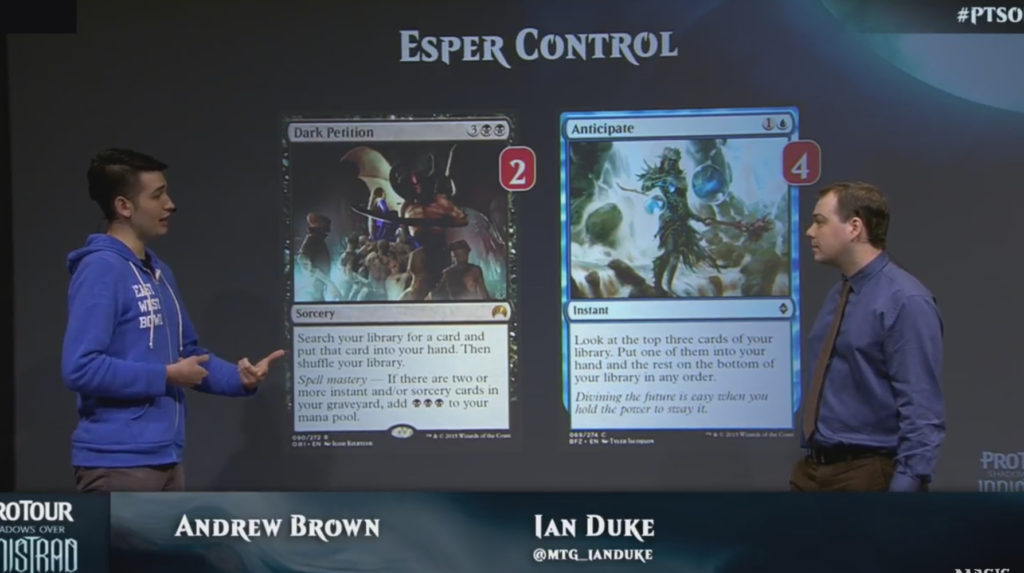
Round 9: Brad Nelson (G/R Goggles) vs. Jon Finkel (B/G Control)
Finkel takes Game 1. In Game 2, Finkel starts his engine with Nissa, Vastwood Seer, ramping a bit to fuel his mana hungry deck. Nelson meanwhile ramps early with Nissa’s Pilgrimage into Goblin Dark Dwellers, casting Pilgrimage immediately for free. What a ramp curve! He then answers Kalitas with his first copy of Pyromancer’s Goggles. Jon casts Transgress the Mind, and finds two copies of Chandra, Flamecaller and a Tireless Tracker. Taking one, he follows up by casting Naturalize to remove the Goggles. Nelson responds with two copies of Tracker, and swings in with Goblin Dark Dwellers, past Nissa and Kalitas. Randy Buehler calls out the Finkel deck as having the better late game vs. Goggles.
Finkel’s first Season’s Past returns four cards, but several turns later, the card advantage from another Goggles on Brad’s side finds Finkel left with just an Ultimate Price and a Infinite Obliteration to answer a Den Protector, GDD and Dragonlord Atarka. With match time an issue, Finkel moves on to Game 3.
In the final game, an pair of Duress in early turns forces Brad to discard Magmatic Insight and Hedron Archive respectively, leaving Brad with limited action. Finkel fields Kalitas on Turn 4, and follows up with Read the Bones into a tapped Hissing Quagmire. Down the road Finkel gets the Dark Petition/Seasons Past loop going and Nelson extends the hand, putting Finkel at the top of the tournament, and leaving Nelson with two losses, both to Jon. Finkel is now very likely to Top 8, which should push Seasons Past over $10.
Shoota Yasooka called out as being the only player to win a single game with Esper Dragons this weekend. LSV is at 11-1 after going 2-1 in his second draft this morning with an amazing UR deck featuring three (!) copies of Fevered Visions.
Setting Up Day 2
After 8 surprising rounds on Friday, including three rounds of draft and five rounds of Standard, a mix of known and established decks have kept the tournament on it’s toes.
So far however, the top table hype has largely been about three new decks:
- G/R Pyromancer’s Goggles (Ramp/Control)
- G/B Aristocrats (Creature Combo)
- G/B Control (Grindy Control)
At the end of Day 1, only two players stood alone at 8-0, having 3-0’d their drafts and boasting a perfect 5-0 record in Standard play. The first Friday hero was Luis Scott-Vargas, beloved Hall of Fame member and pivotal team mate on Team Channel Fireball. Both LSV and some of his teammates were on a post-Rally version of G/B Aristocrats that aimed to take advantage of the low potential to interact and disrupt found in the prevalent Bant Company and Wx Humans builds. The deck functions by dumping a pile of small creatures into play, often accelerated by the mana producing abilities of Cryptolith Rite, and quickly finds the Zulaport Cutthroat and Nantuko Husk, sacrifices the team and drains out the opponent. In longer games, Westvale Abbey provides reach by presenting a must answer flying, indestructible demon threat.
Our other 8-0 player coming into the second day of the tournament is Brad Nelson, SCG alumni and former Player of the Year, sporting an innovative GR Pyromancer’s Goggles build that leveraged cards including World Breaker and spells like Fall of the Titans, copied by Goggles to finish off opponents in style.
Pro Tour great Jon Finkel was on the GB Control deck, managing to pilot the deck to a 4-1 finish after 3-0’ing his draft. This deck leverages the much maligned SOI mythic Season’s Past, alongside Dark Petition. Combined the two cards can recursively generate massive amounts of card advantadge, providing their pilot with additional chances to cast the likes of Duress, Transgress the Mind, Ruinous Path and Kalitas, Traitor of Ghet.
Other decks in top table contention include Mardu Control, Esper Dragons, Jund and Abzan Collected Company builds, and UR Goggles.
The financial stories of the weekend thus far mostly revolve around the stampede to buy out cards from the new archetypes that were put on display on camera at the top tables on day 1.
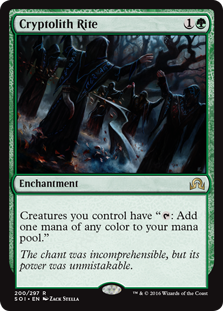
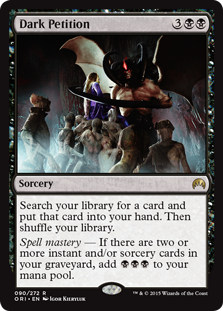
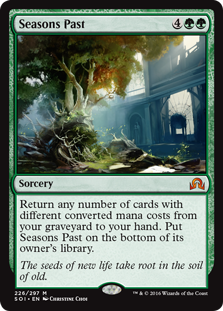
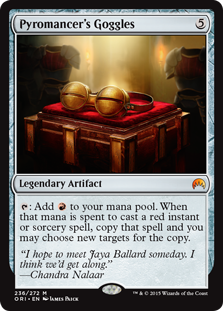
Here are the cards that showed significant movement Friday as speculators moved in on the hot new tech.
- Cryptolith Rite: $3.50 to $7 (+100%)
- Dark Petition: $1 to $5 (+400%)
- Seasons Past: $2 to $8 (+300%)
- Pyromancer’s Goggles: $8 to $14 (+75%)
- Demonic Pact: $1.50 to $2.50 (+40%)
The themes here are twofold: underrated build around rares and mythics, and to a more limited extent, rares and mythics from Origins that were previously price suppressed by the presence of Jace, Vryn’s Prodigy in that set. With spikes this large, selling into the hype is the best possible advice, with only Goggles in position to top $20 if it makes another Top 8. The rest of these cards are likely to slide back 20-50% over the next week or two unless they claim a Top 8 finish on Sunday. For that to happen, their pilots will likely need to go 5-2-1 or better today.
Follow along with us as we follow along with the final 5 rounds of constructed play before the cut to Top 8 and the establishment of the new Standard metagame.
James Chillcott is the CEO of ShelfLife.net, The Future of Collecting, Senior Partner at Advoca, a designer, adventurer, toy fanatic and an avid Magic player and collector since 1994.
